Lines in perspective
![]()
Let’s investigate. The line of the road
While I was taking these pictures, I was paying attention to the direction of one of the lines—always the same one—while using one of our secret weapons. I encrypted my observations so that they would remain confidential!
![]() Now it’s your turn!
Now it’s your turn!
- 1. Connect each picture to its corresponding coded document.
- 2. Which line was I studying? Run your finger along the line in each picture in order to find it if you need to.
- 3. What is the orientation of the line in each picture? Do you think I tilted the camera to get these results?
- 4. Which of the secret weapons allowed me to change the direction of the line here?

Hint: Do you think my feet were always in the same place on the road?
1. A2, B3, C1.
2. The line that I was studying is the border between the road and the grass.
3. The line is horizontal in picture A; diagonal in picture B; and vertical, straight up and down, in picture C! And yet, it doesn’t look as though the camera was tilted: the landscape still looks normal, and so does the house.
4. I used secret weapon no. 3, the three-dimensional weapon! I got closer and closer to the line and turned my body in order to change the direction of the line in each picture.
Deductions. The weapon of the three dimensions in the service of composition
Who would have thought it? The secret weapon of the three dimensions ALSO allows us to choose the orientation of a line in a picture! Just by moving farther away from or closer to a line, you can decide whether it will be horizontal, diagonal, or vertical, and make your composition better that way. It’s crazy!

Strategy. Orienting with your feet
This strategy will help you to become a master of the lines!
This technique works with lines that are lying down (horizontal lines)—a line drawn on the ground, the edge of a table, a shelf, the guardrail on a bridge—but NOT with vertical lines, like poles or tree trunks.
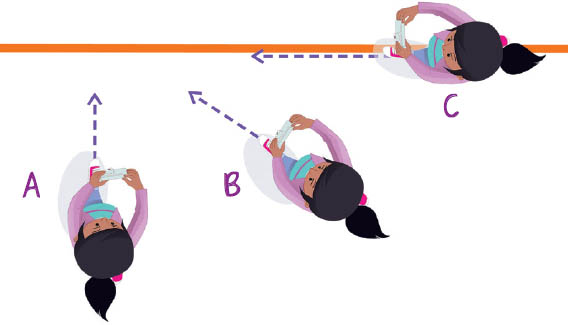
- A. Stand facing the line to make it appear horizontal.
- B. Stand pretty close to the line and rotate your body slightly. Now the line will look diagonal in the picture.
- C. Stand with your feet right on the line (or on an imaginary line extending out from it) and rotate your body some more so that you’re looking at the line along its axis. Now it will be vertical!
![]()
Picture quest. Taming the lines
![]() Now it’s your turn to tame a line on the ground!
Now it’s your turn to tame a line on the ground!
- 1. Decide which line is going to be your main line. I chose the edge of a rug, but you could also use a board in a wooden floor, the edge of a garden walkway, a sidewalk, a road, a path . . .
- 2. Walk away from the line, walk up closer to it, or even turn in place, without losing your sight line! Notice the direction of the line in the frame while you are moving around, as well as the composition of your picture. Always keep your camera nice and straight, with either a horizontal or a vertical format. It’s your feet that should move, not the camera!
- 3. Try to take pictures in which your line is horizontal (A), diagonal (B), and vertical (C) just by moving around!
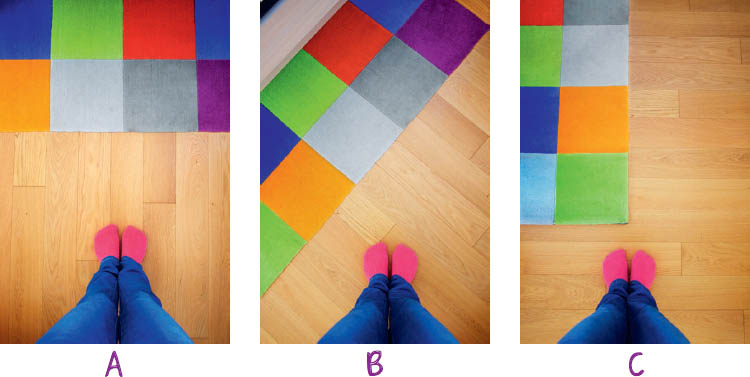
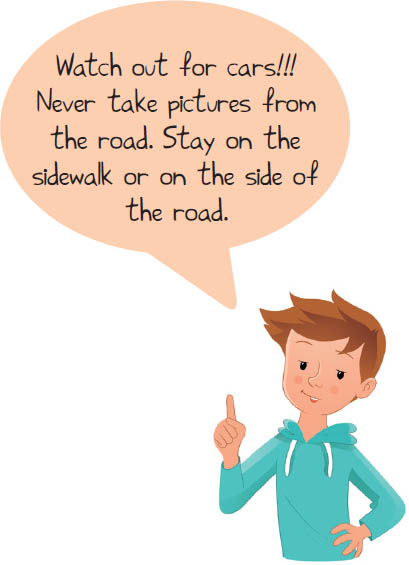
If you have trouble creating the composition that you were imagining, then at the very end, you can use secret weapon no. 2 just a little! Tilt your camera slightly, if necessary, so that the line is going in the direction that you want it to.
Considering the evidence. Under the bridge
Here are three new pieces of evidence so that we can confirm our conclusions.
![]() The photographer who took these pictures made the following statements. But watch out, this sly person does not always tell the truth! Find the lie that is hidden among these declarations.
The photographer who took these pictures made the following statements. But watch out, this sly person does not always tell the truth! Find the lie that is hidden among these declarations.
- A. It was gorgeous weather that day.
- B. All of a sudden, I saw this enormous bridge—very impressive! I took a picture of it from far away, and then I got closer.
- C. First, the top of the bridge looked horizontal in my pictures, and then it started to tilt in the frame.
- D. The line between the field and the bridge started to tilt too, but in the other direction!
- E. Finally, I used a vertical format so that I could get a good picture of this very tilted line.
Sentence D is a lie. The line between the field and the bridge does not change its orientation. It doesn’t tilt at all! It is horizontal in all of the pictures.
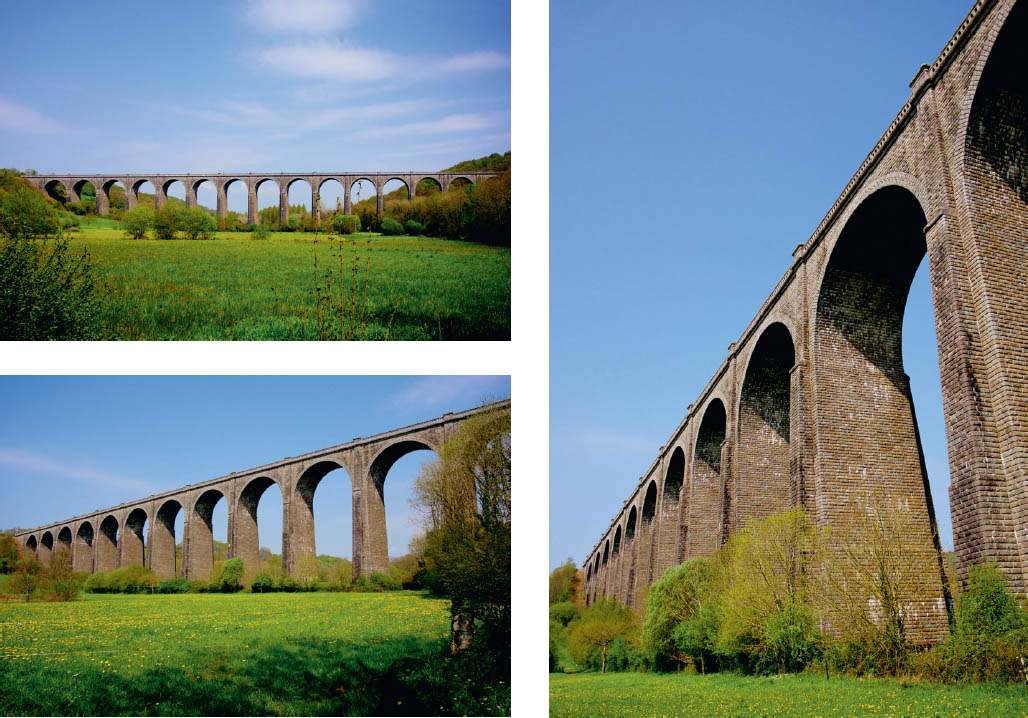
![]()
Further investigation. What do you feel?
![]() Let’s investigate the pictures of the bridge a little further. Of the three pictures here, which ones seems:
Let’s investigate the pictures of the bridge a little further. Of the three pictures here, which ones seems:
- 1. the calmest and most restful to you?
- 2. the most lively and dynamic to you?
The first picture, which shows the bridge from far away and in which all the lines horizontal, is the calmest and most restful. The third photo is the most dynamic one. You could almost imagine a train going across it at top speed!
Strategy. Lines with emotions
Lines give personality to our pictures. It’s true! Horizontal lines are gentle, calm, restful lines. A picture that is full of horizontal lines is like a view of the seaside on vacation. It makes you feel like relaxing in the sun.

Tilted or diagonal lines are lively, dynamic, and expressive. A picture that is full of diagonal lines is like a train zooming across a bridge or through a tunnel at top speed! It sounds like it’s saying “whaaaaaow!”


So then what about vertical lines? Well, they are between the two: less restful than horizontal lines but less dynamic than diagonals! They make us think of a forest filled with trees stretching toward the sky. They make us want to look up and stretch upward too, to try and touch the clouds.

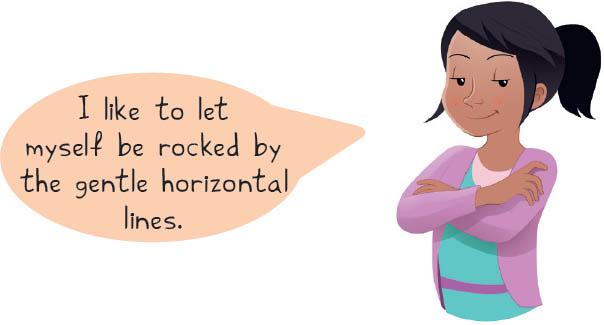
Isn’t it great to be able to choose how to orient the lines in your pictures, using your high-tech weapons no. 2 and no. 3? This way, you can decide whether you want your picture to be calm and restful or lively and dynamic!
![]()
Picture quest. Off to find lines
![]() Hunt for lines all around you. You will see that they are EVERYWHERE. It’s absolutely crazy!
Hunt for lines all around you. You will see that they are EVERYWHERE. It’s absolutely crazy!
- 1. Take a calm, restful picture, showing mostly objects that are lying down and horizontal lines piled up one on top of one another.
- 2. Now take a picture showing vertical lines arranged sort of like bars rising toward the sky.
- 3. And finally, take a dynamic picture with tilted lines! Try to position the main line on an exact diagonal right across your picture.


